Primary Healthcare and Immunization Issues in Canada: A Report
VerifiedAdded on 2022/11/03
|11
|3099
|493
Report
AI Summary
This report examines immunization issues in Canada, highlighting it as a significant public health concern affecting both children and adults. The study identifies key social determinants of health, including household living conditions, program accessibility, health inequality, financial factors, and lack of social justice, as contributing factors to the problem. It references epidemiological studies conducted in Canada related to immunization, emphasizing the role of primary healthcare nurses. These nurses are responsible for educating patients about immunization benefits, addressing risks, and promoting awareness, along with actively participating in immunization advisory committees. The report also stresses the importance of cultural competence in the healthcare setting to address the diverse population of Canada and reduce health disparities, ultimately improving immunization rates and patient outcomes. The conclusion emphasizes the need for improved accessibility and affordability of immunization programs to protect the population from adverse health effects.
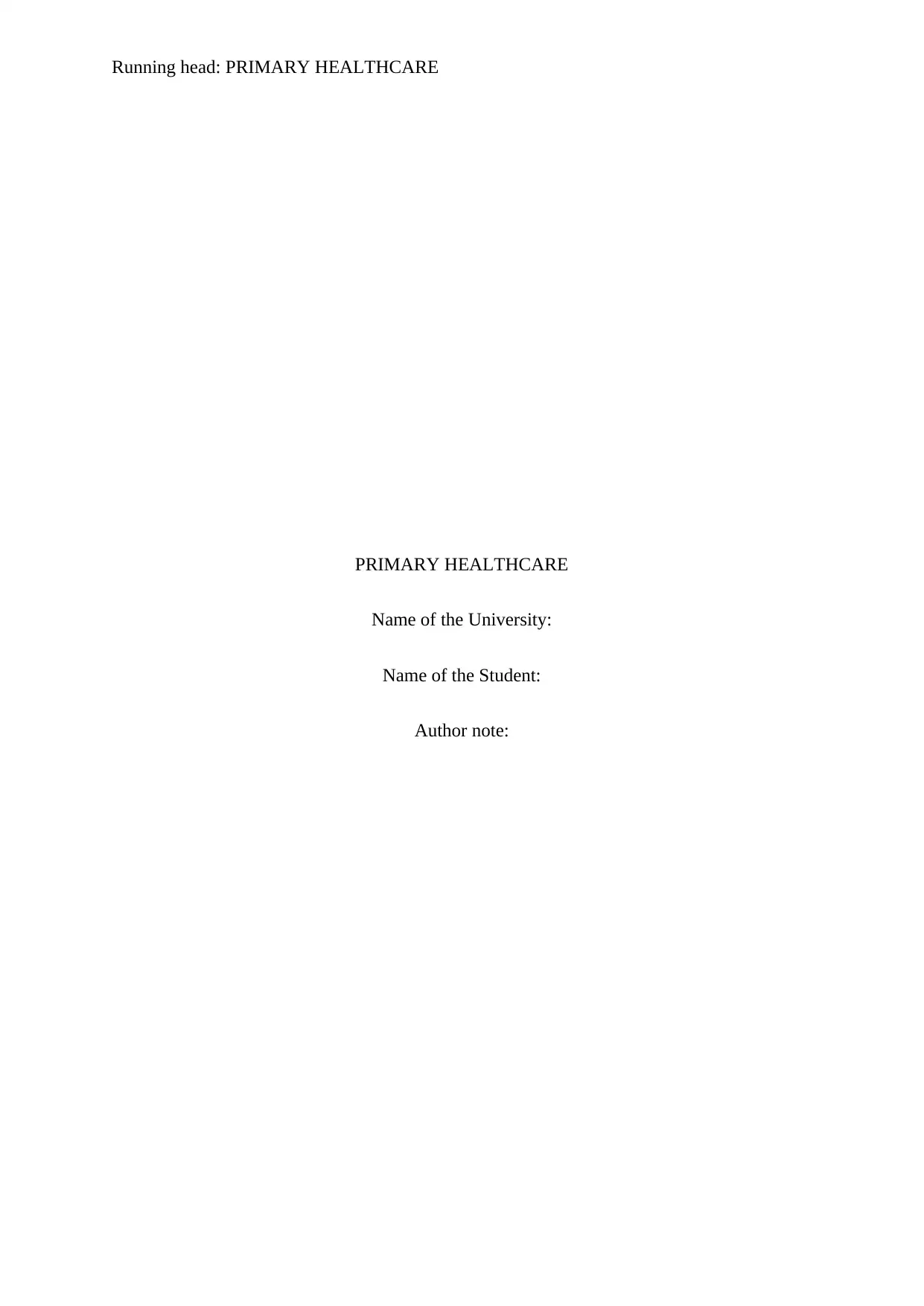
Running head: PRIMARY HEALTHCARE
PRIMARY HEALTHCARE
Name of the University:
Name of the Student:
Author note:
PRIMARY HEALTHCARE
Name of the University:
Name of the Student:
Author note:
Paraphrase This Document
Need a fresh take? Get an instant paraphrase of this document with our AI Paraphraser
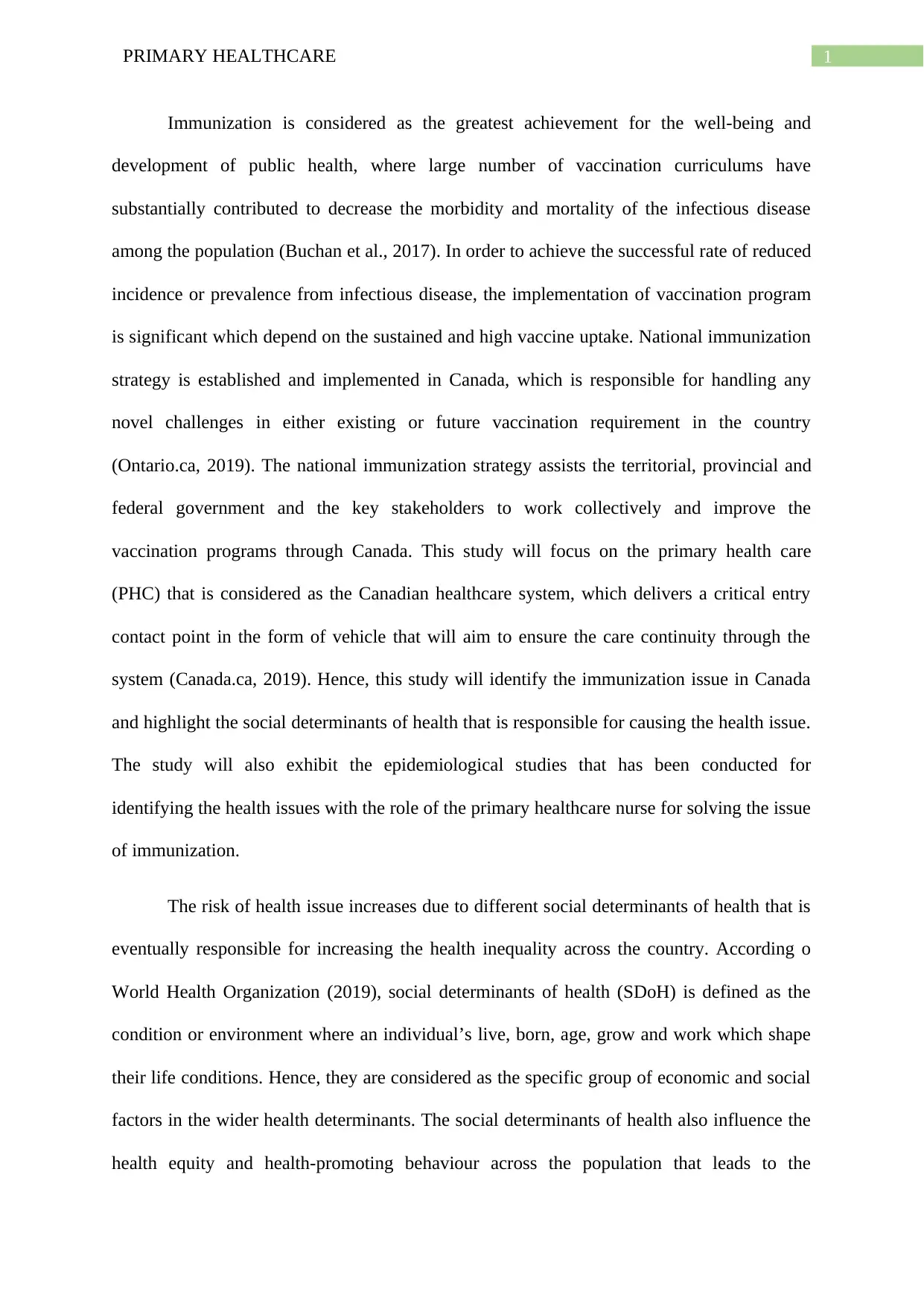
1PRIMARY HEALTHCARE
Immunization is considered as the greatest achievement for the well-being and
development of public health, where large number of vaccination curriculums have
substantially contributed to decrease the morbidity and mortality of the infectious disease
among the population (Buchan et al., 2017). In order to achieve the successful rate of reduced
incidence or prevalence from infectious disease, the implementation of vaccination program
is significant which depend on the sustained and high vaccine uptake. National immunization
strategy is established and implemented in Canada, which is responsible for handling any
novel challenges in either existing or future vaccination requirement in the country
(Ontario.ca, 2019). The national immunization strategy assists the territorial, provincial and
federal government and the key stakeholders to work collectively and improve the
vaccination programs through Canada. This study will focus on the primary health care
(PHC) that is considered as the Canadian healthcare system, which delivers a critical entry
contact point in the form of vehicle that will aim to ensure the care continuity through the
system (Canada.ca, 2019). Hence, this study will identify the immunization issue in Canada
and highlight the social determinants of health that is responsible for causing the health issue.
The study will also exhibit the epidemiological studies that has been conducted for
identifying the health issues with the role of the primary healthcare nurse for solving the issue
of immunization.
The risk of health issue increases due to different social determinants of health that is
eventually responsible for increasing the health inequality across the country. According o
World Health Organization (2019), social determinants of health (SDoH) is defined as the
condition or environment where an individual’s live, born, age, grow and work which shape
their life conditions. Hence, they are considered as the specific group of economic and social
factors in the wider health determinants. The social determinants of health also influence the
health equity and health-promoting behaviour across the population that leads to the
Immunization is considered as the greatest achievement for the well-being and
development of public health, where large number of vaccination curriculums have
substantially contributed to decrease the morbidity and mortality of the infectious disease
among the population (Buchan et al., 2017). In order to achieve the successful rate of reduced
incidence or prevalence from infectious disease, the implementation of vaccination program
is significant which depend on the sustained and high vaccine uptake. National immunization
strategy is established and implemented in Canada, which is responsible for handling any
novel challenges in either existing or future vaccination requirement in the country
(Ontario.ca, 2019). The national immunization strategy assists the territorial, provincial and
federal government and the key stakeholders to work collectively and improve the
vaccination programs through Canada. This study will focus on the primary health care
(PHC) that is considered as the Canadian healthcare system, which delivers a critical entry
contact point in the form of vehicle that will aim to ensure the care continuity through the
system (Canada.ca, 2019). Hence, this study will identify the immunization issue in Canada
and highlight the social determinants of health that is responsible for causing the health issue.
The study will also exhibit the epidemiological studies that has been conducted for
identifying the health issues with the role of the primary healthcare nurse for solving the issue
of immunization.
The risk of health issue increases due to different social determinants of health that is
eventually responsible for increasing the health inequality across the country. According o
World Health Organization (2019), social determinants of health (SDoH) is defined as the
condition or environment where an individual’s live, born, age, grow and work which shape
their life conditions. Hence, they are considered as the specific group of economic and social
factors in the wider health determinants. The social determinants of health also influence the
health equity and health-promoting behaviour across the population that leads to the
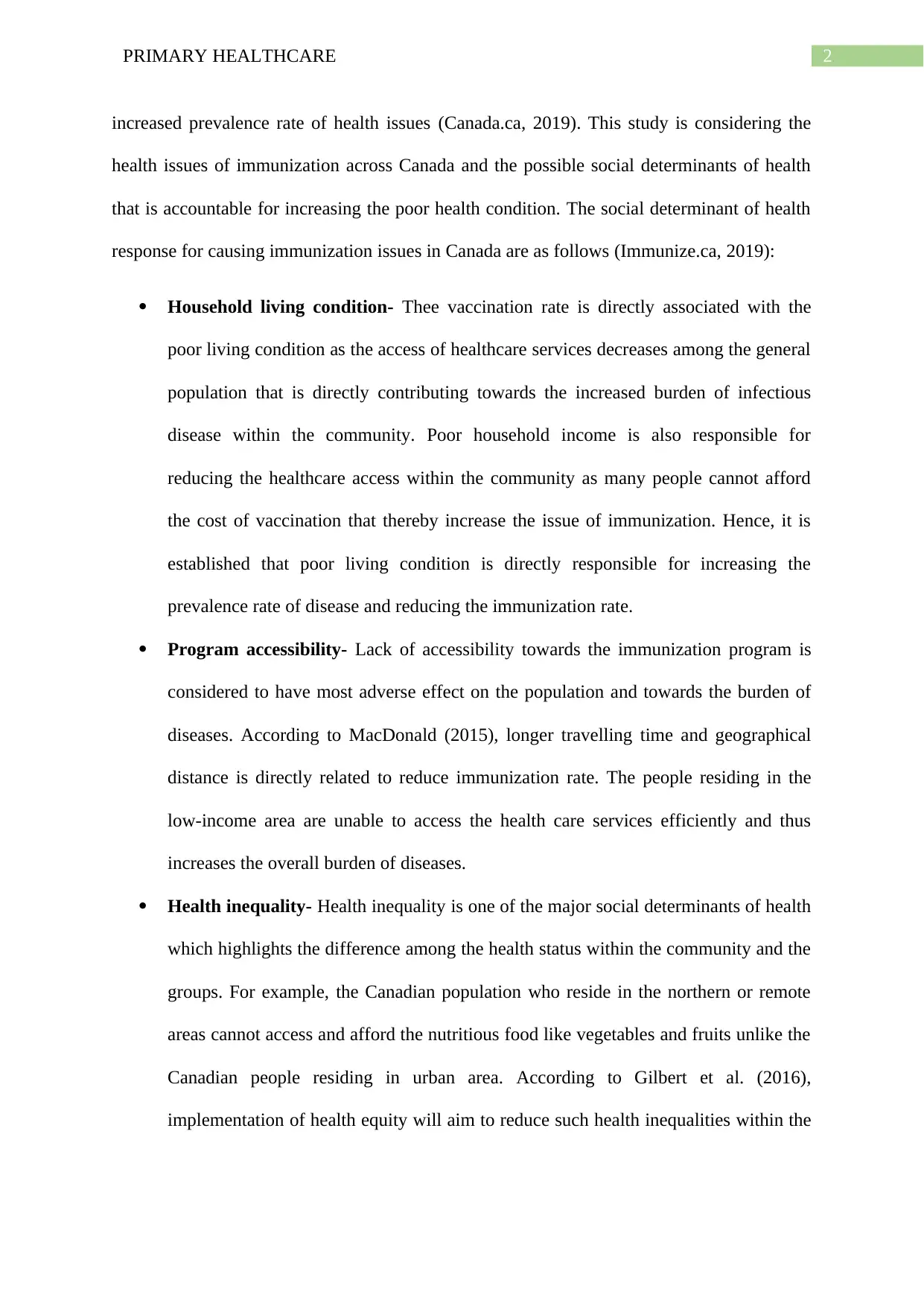
2PRIMARY HEALTHCARE
increased prevalence rate of health issues (Canada.ca, 2019). This study is considering the
health issues of immunization across Canada and the possible social determinants of health
that is accountable for increasing the poor health condition. The social determinant of health
response for causing immunization issues in Canada are as follows (Immunize.ca, 2019):
Household living condition- Thee vaccination rate is directly associated with the
poor living condition as the access of healthcare services decreases among the general
population that is directly contributing towards the increased burden of infectious
disease within the community. Poor household income is also responsible for
reducing the healthcare access within the community as many people cannot afford
the cost of vaccination that thereby increase the issue of immunization. Hence, it is
established that poor living condition is directly responsible for increasing the
prevalence rate of disease and reducing the immunization rate.
Program accessibility- Lack of accessibility towards the immunization program is
considered to have most adverse effect on the population and towards the burden of
diseases. According to MacDonald (2015), longer travelling time and geographical
distance is directly related to reduce immunization rate. The people residing in the
low-income area are unable to access the health care services efficiently and thus
increases the overall burden of diseases.
Health inequality- Health inequality is one of the major social determinants of health
which highlights the difference among the health status within the community and the
groups. For example, the Canadian population who reside in the northern or remote
areas cannot access and afford the nutritious food like vegetables and fruits unlike the
Canadian people residing in urban area. According to Gilbert et al. (2016),
implementation of health equity will aim to reduce such health inequalities within the
increased prevalence rate of health issues (Canada.ca, 2019). This study is considering the
health issues of immunization across Canada and the possible social determinants of health
that is accountable for increasing the poor health condition. The social determinant of health
response for causing immunization issues in Canada are as follows (Immunize.ca, 2019):
Household living condition- Thee vaccination rate is directly associated with the
poor living condition as the access of healthcare services decreases among the general
population that is directly contributing towards the increased burden of infectious
disease within the community. Poor household income is also responsible for
reducing the healthcare access within the community as many people cannot afford
the cost of vaccination that thereby increase the issue of immunization. Hence, it is
established that poor living condition is directly responsible for increasing the
prevalence rate of disease and reducing the immunization rate.
Program accessibility- Lack of accessibility towards the immunization program is
considered to have most adverse effect on the population and towards the burden of
diseases. According to MacDonald (2015), longer travelling time and geographical
distance is directly related to reduce immunization rate. The people residing in the
low-income area are unable to access the health care services efficiently and thus
increases the overall burden of diseases.
Health inequality- Health inequality is one of the major social determinants of health
which highlights the difference among the health status within the community and the
groups. For example, the Canadian population who reside in the northern or remote
areas cannot access and afford the nutritious food like vegetables and fruits unlike the
Canadian people residing in urban area. According to Gilbert et al. (2016),
implementation of health equity will aim to reduce such health inequalities within the
⊘ This is a preview!⊘
Do you want full access?
Subscribe today to unlock all pages.

Trusted by 1+ million students worldwide
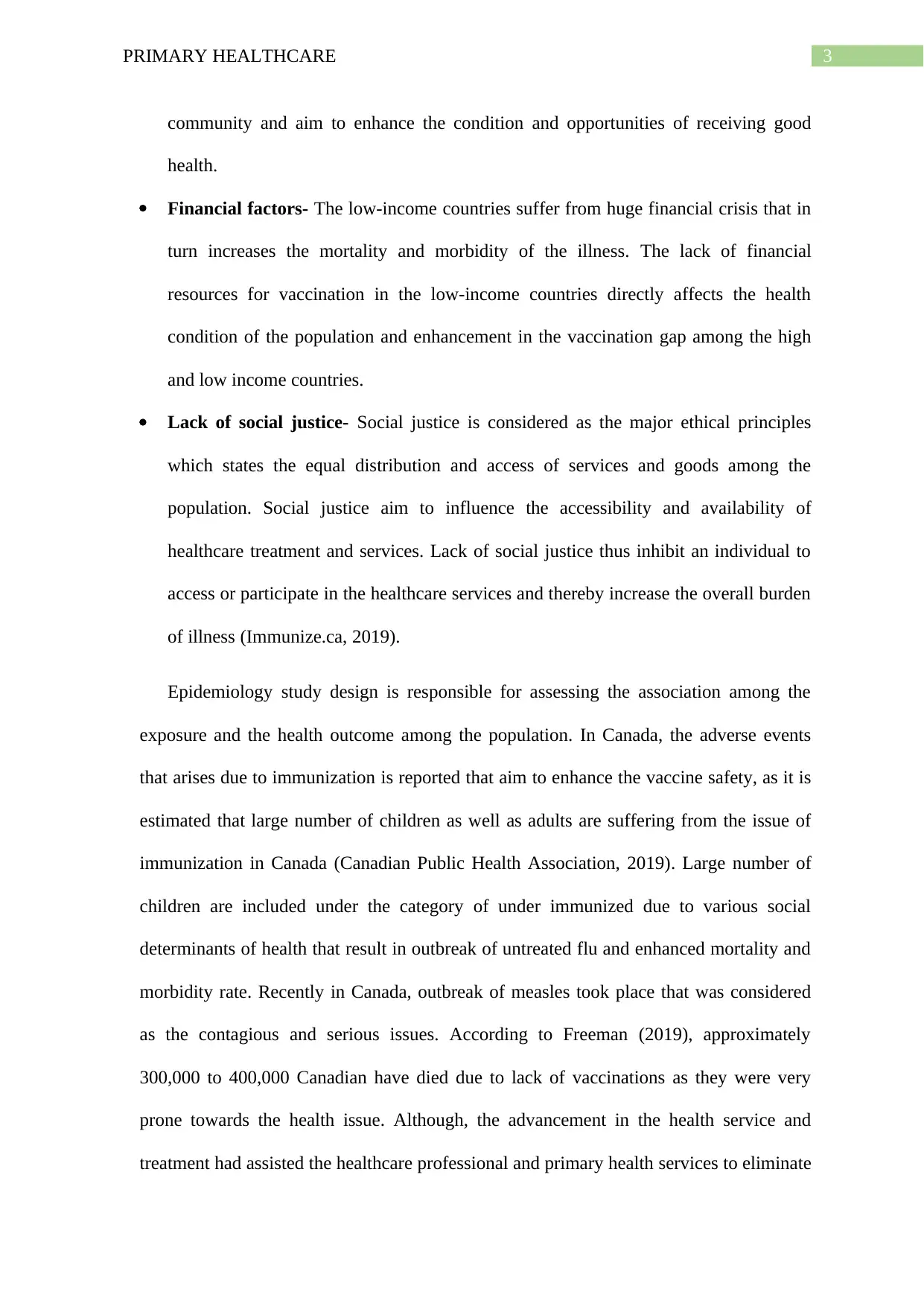
3PRIMARY HEALTHCARE
community and aim to enhance the condition and opportunities of receiving good
health.
Financial factors- The low-income countries suffer from huge financial crisis that in
turn increases the mortality and morbidity of the illness. The lack of financial
resources for vaccination in the low-income countries directly affects the health
condition of the population and enhancement in the vaccination gap among the high
and low income countries.
Lack of social justice- Social justice is considered as the major ethical principles
which states the equal distribution and access of services and goods among the
population. Social justice aim to influence the accessibility and availability of
healthcare treatment and services. Lack of social justice thus inhibit an individual to
access or participate in the healthcare services and thereby increase the overall burden
of illness (Immunize.ca, 2019).
Epidemiology study design is responsible for assessing the association among the
exposure and the health outcome among the population. In Canada, the adverse events
that arises due to immunization is reported that aim to enhance the vaccine safety, as it is
estimated that large number of children as well as adults are suffering from the issue of
immunization in Canada (Canadian Public Health Association, 2019). Large number of
children are included under the category of under immunized due to various social
determinants of health that result in outbreak of untreated flu and enhanced mortality and
morbidity rate. Recently in Canada, outbreak of measles took place that was considered
as the contagious and serious issues. According to Freeman (2019), approximately
300,000 to 400,000 Canadian have died due to lack of vaccinations as they were very
prone towards the health issue. Although, the advancement in the health service and
treatment had assisted the healthcare professional and primary health services to eliminate
community and aim to enhance the condition and opportunities of receiving good
health.
Financial factors- The low-income countries suffer from huge financial crisis that in
turn increases the mortality and morbidity of the illness. The lack of financial
resources for vaccination in the low-income countries directly affects the health
condition of the population and enhancement in the vaccination gap among the high
and low income countries.
Lack of social justice- Social justice is considered as the major ethical principles
which states the equal distribution and access of services and goods among the
population. Social justice aim to influence the accessibility and availability of
healthcare treatment and services. Lack of social justice thus inhibit an individual to
access or participate in the healthcare services and thereby increase the overall burden
of illness (Immunize.ca, 2019).
Epidemiology study design is responsible for assessing the association among the
exposure and the health outcome among the population. In Canada, the adverse events
that arises due to immunization is reported that aim to enhance the vaccine safety, as it is
estimated that large number of children as well as adults are suffering from the issue of
immunization in Canada (Canadian Public Health Association, 2019). Large number of
children are included under the category of under immunized due to various social
determinants of health that result in outbreak of untreated flu and enhanced mortality and
morbidity rate. Recently in Canada, outbreak of measles took place that was considered
as the contagious and serious issues. According to Freeman (2019), approximately
300,000 to 400,000 Canadian have died due to lack of vaccinations as they were very
prone towards the health issue. Although, the advancement in the health service and
treatment had assisted the healthcare professional and primary health services to eliminate
Paraphrase This Document
Need a fresh take? Get an instant paraphrase of this document with our AI Paraphraser
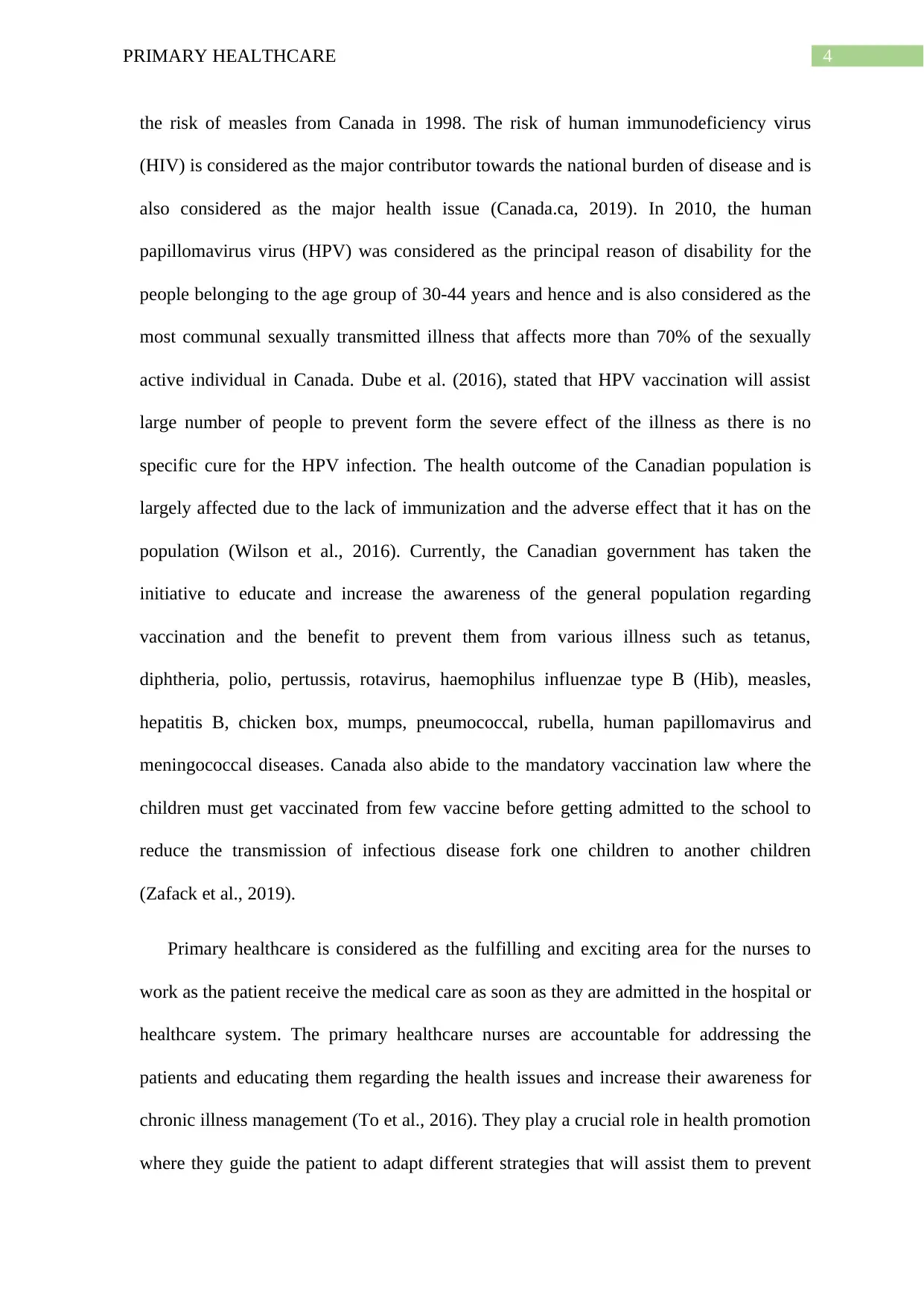
4PRIMARY HEALTHCARE
the risk of measles from Canada in 1998. The risk of human immunodeficiency virus
(HIV) is considered as the major contributor towards the national burden of disease and is
also considered as the major health issue (Canada.ca, 2019). In 2010, the human
papillomavirus virus (HPV) was considered as the principal reason of disability for the
people belonging to the age group of 30-44 years and hence and is also considered as the
most communal sexually transmitted illness that affects more than 70% of the sexually
active individual in Canada. Dube et al. (2016), stated that HPV vaccination will assist
large number of people to prevent form the severe effect of the illness as there is no
specific cure for the HPV infection. The health outcome of the Canadian population is
largely affected due to the lack of immunization and the adverse effect that it has on the
population (Wilson et al., 2016). Currently, the Canadian government has taken the
initiative to educate and increase the awareness of the general population regarding
vaccination and the benefit to prevent them from various illness such as tetanus,
diphtheria, polio, pertussis, rotavirus, haemophilus influenzae type B (Hib), measles,
hepatitis B, chicken box, mumps, pneumococcal, rubella, human papillomavirus and
meningococcal diseases. Canada also abide to the mandatory vaccination law where the
children must get vaccinated from few vaccine before getting admitted to the school to
reduce the transmission of infectious disease fork one children to another children
(Zafack et al., 2019).
Primary healthcare is considered as the fulfilling and exciting area for the nurses to
work as the patient receive the medical care as soon as they are admitted in the hospital or
healthcare system. The primary healthcare nurses are accountable for addressing the
patients and educating them regarding the health issues and increase their awareness for
chronic illness management (To et al., 2016). They play a crucial role in health promotion
where they guide the patient to adapt different strategies that will assist them to prevent
the risk of measles from Canada in 1998. The risk of human immunodeficiency virus
(HIV) is considered as the major contributor towards the national burden of disease and is
also considered as the major health issue (Canada.ca, 2019). In 2010, the human
papillomavirus virus (HPV) was considered as the principal reason of disability for the
people belonging to the age group of 30-44 years and hence and is also considered as the
most communal sexually transmitted illness that affects more than 70% of the sexually
active individual in Canada. Dube et al. (2016), stated that HPV vaccination will assist
large number of people to prevent form the severe effect of the illness as there is no
specific cure for the HPV infection. The health outcome of the Canadian population is
largely affected due to the lack of immunization and the adverse effect that it has on the
population (Wilson et al., 2016). Currently, the Canadian government has taken the
initiative to educate and increase the awareness of the general population regarding
vaccination and the benefit to prevent them from various illness such as tetanus,
diphtheria, polio, pertussis, rotavirus, haemophilus influenzae type B (Hib), measles,
hepatitis B, chicken box, mumps, pneumococcal, rubella, human papillomavirus and
meningococcal diseases. Canada also abide to the mandatory vaccination law where the
children must get vaccinated from few vaccine before getting admitted to the school to
reduce the transmission of infectious disease fork one children to another children
(Zafack et al., 2019).
Primary healthcare is considered as the fulfilling and exciting area for the nurses to
work as the patient receive the medical care as soon as they are admitted in the hospital or
healthcare system. The primary healthcare nurses are accountable for addressing the
patients and educating them regarding the health issues and increase their awareness for
chronic illness management (To et al., 2016). They play a crucial role in health promotion
where they guide the patient to adapt different strategies that will assist them to prevent
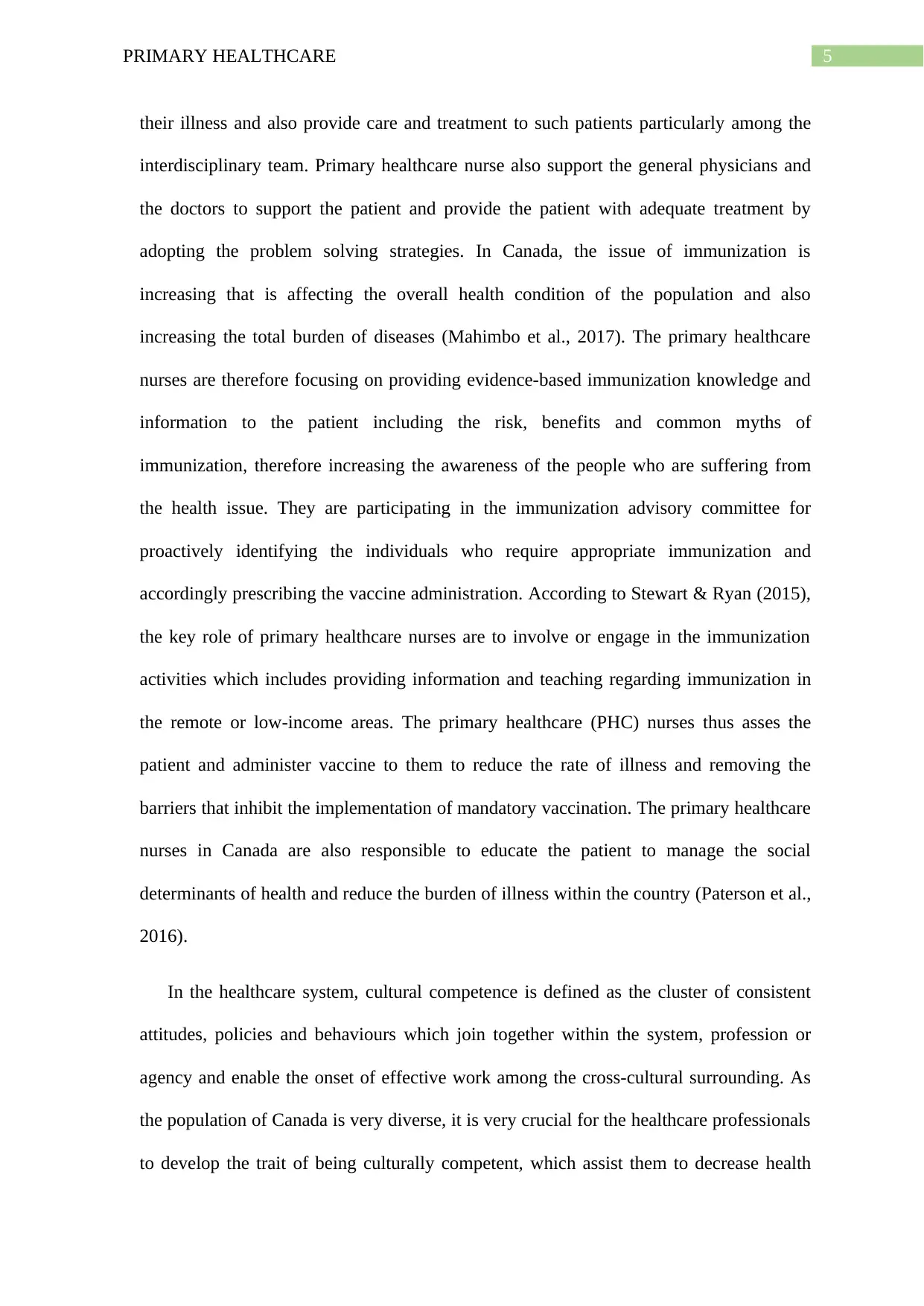
5PRIMARY HEALTHCARE
their illness and also provide care and treatment to such patients particularly among the
interdisciplinary team. Primary healthcare nurse also support the general physicians and
the doctors to support the patient and provide the patient with adequate treatment by
adopting the problem solving strategies. In Canada, the issue of immunization is
increasing that is affecting the overall health condition of the population and also
increasing the total burden of diseases (Mahimbo et al., 2017). The primary healthcare
nurses are therefore focusing on providing evidence-based immunization knowledge and
information to the patient including the risk, benefits and common myths of
immunization, therefore increasing the awareness of the people who are suffering from
the health issue. They are participating in the immunization advisory committee for
proactively identifying the individuals who require appropriate immunization and
accordingly prescribing the vaccine administration. According to Stewart & Ryan (2015),
the key role of primary healthcare nurses are to involve or engage in the immunization
activities which includes providing information and teaching regarding immunization in
the remote or low-income areas. The primary healthcare (PHC) nurses thus asses the
patient and administer vaccine to them to reduce the rate of illness and removing the
barriers that inhibit the implementation of mandatory vaccination. The primary healthcare
nurses in Canada are also responsible to educate the patient to manage the social
determinants of health and reduce the burden of illness within the country (Paterson et al.,
2016).
In the healthcare system, cultural competence is defined as the cluster of consistent
attitudes, policies and behaviours which join together within the system, profession or
agency and enable the onset of effective work among the cross-cultural surrounding. As
the population of Canada is very diverse, it is very crucial for the healthcare professionals
to develop the trait of being culturally competent, which assist them to decrease health
their illness and also provide care and treatment to such patients particularly among the
interdisciplinary team. Primary healthcare nurse also support the general physicians and
the doctors to support the patient and provide the patient with adequate treatment by
adopting the problem solving strategies. In Canada, the issue of immunization is
increasing that is affecting the overall health condition of the population and also
increasing the total burden of diseases (Mahimbo et al., 2017). The primary healthcare
nurses are therefore focusing on providing evidence-based immunization knowledge and
information to the patient including the risk, benefits and common myths of
immunization, therefore increasing the awareness of the people who are suffering from
the health issue. They are participating in the immunization advisory committee for
proactively identifying the individuals who require appropriate immunization and
accordingly prescribing the vaccine administration. According to Stewart & Ryan (2015),
the key role of primary healthcare nurses are to involve or engage in the immunization
activities which includes providing information and teaching regarding immunization in
the remote or low-income areas. The primary healthcare (PHC) nurses thus asses the
patient and administer vaccine to them to reduce the rate of illness and removing the
barriers that inhibit the implementation of mandatory vaccination. The primary healthcare
nurses in Canada are also responsible to educate the patient to manage the social
determinants of health and reduce the burden of illness within the country (Paterson et al.,
2016).
In the healthcare system, cultural competence is defined as the cluster of consistent
attitudes, policies and behaviours which join together within the system, profession or
agency and enable the onset of effective work among the cross-cultural surrounding. As
the population of Canada is very diverse, it is very crucial for the healthcare professionals
to develop the trait of being culturally competent, which assist them to decrease health
⊘ This is a preview!⊘
Do you want full access?
Subscribe today to unlock all pages.

Trusted by 1+ million students worldwide
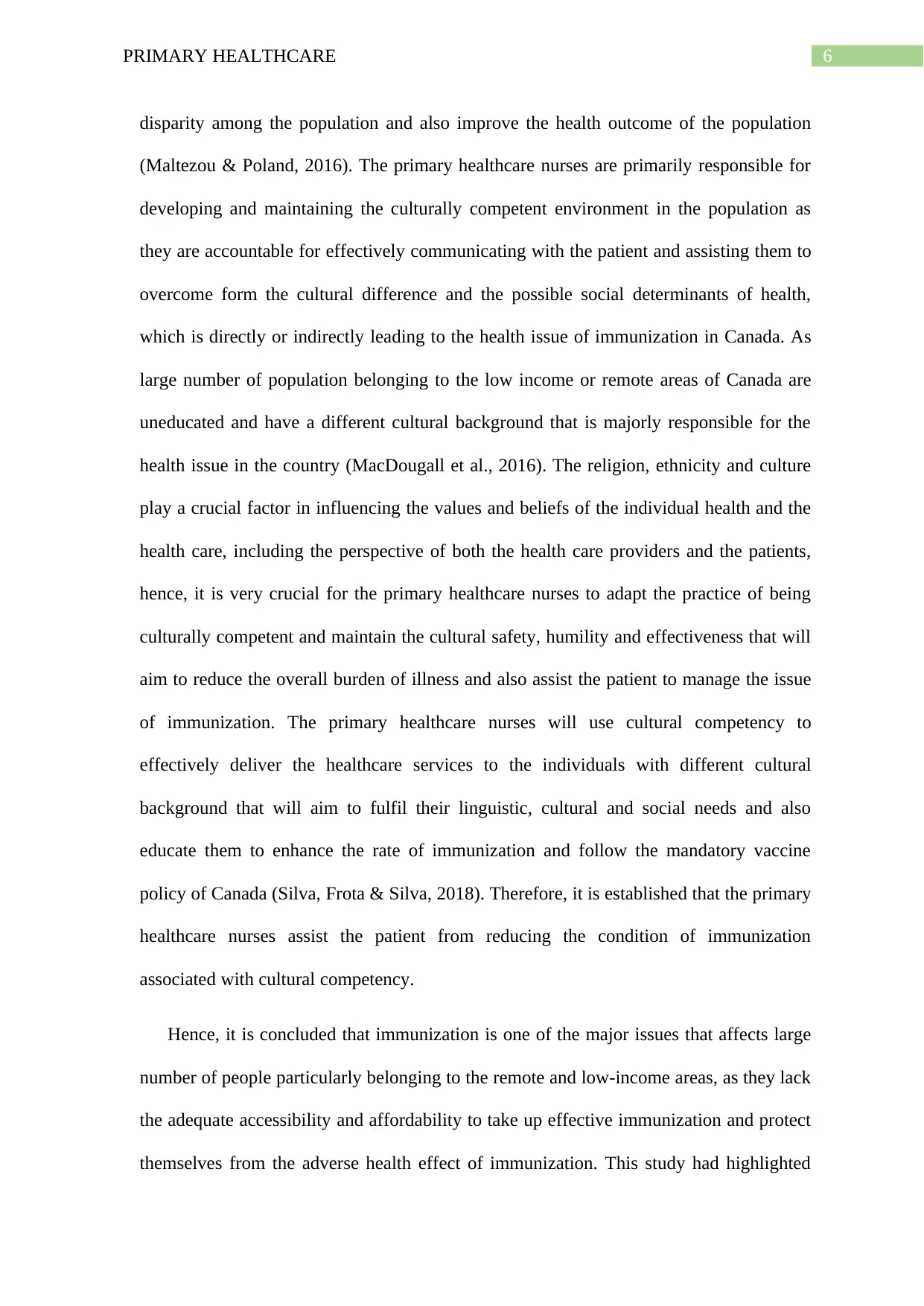
6PRIMARY HEALTHCARE
disparity among the population and also improve the health outcome of the population
(Maltezou & Poland, 2016). The primary healthcare nurses are primarily responsible for
developing and maintaining the culturally competent environment in the population as
they are accountable for effectively communicating with the patient and assisting them to
overcome form the cultural difference and the possible social determinants of health,
which is directly or indirectly leading to the health issue of immunization in Canada. As
large number of population belonging to the low income or remote areas of Canada are
uneducated and have a different cultural background that is majorly responsible for the
health issue in the country (MacDougall et al., 2016). The religion, ethnicity and culture
play a crucial factor in influencing the values and beliefs of the individual health and the
health care, including the perspective of both the health care providers and the patients,
hence, it is very crucial for the primary healthcare nurses to adapt the practice of being
culturally competent and maintain the cultural safety, humility and effectiveness that will
aim to reduce the overall burden of illness and also assist the patient to manage the issue
of immunization. The primary healthcare nurses will use cultural competency to
effectively deliver the healthcare services to the individuals with different cultural
background that will aim to fulfil their linguistic, cultural and social needs and also
educate them to enhance the rate of immunization and follow the mandatory vaccine
policy of Canada (Silva, Frota & Silva, 2018). Therefore, it is established that the primary
healthcare nurses assist the patient from reducing the condition of immunization
associated with cultural competency.
Hence, it is concluded that immunization is one of the major issues that affects large
number of people particularly belonging to the remote and low-income areas, as they lack
the adequate accessibility and affordability to take up effective immunization and protect
themselves from the adverse health effect of immunization. This study had highlighted
disparity among the population and also improve the health outcome of the population
(Maltezou & Poland, 2016). The primary healthcare nurses are primarily responsible for
developing and maintaining the culturally competent environment in the population as
they are accountable for effectively communicating with the patient and assisting them to
overcome form the cultural difference and the possible social determinants of health,
which is directly or indirectly leading to the health issue of immunization in Canada. As
large number of population belonging to the low income or remote areas of Canada are
uneducated and have a different cultural background that is majorly responsible for the
health issue in the country (MacDougall et al., 2016). The religion, ethnicity and culture
play a crucial factor in influencing the values and beliefs of the individual health and the
health care, including the perspective of both the health care providers and the patients,
hence, it is very crucial for the primary healthcare nurses to adapt the practice of being
culturally competent and maintain the cultural safety, humility and effectiveness that will
aim to reduce the overall burden of illness and also assist the patient to manage the issue
of immunization. The primary healthcare nurses will use cultural competency to
effectively deliver the healthcare services to the individuals with different cultural
background that will aim to fulfil their linguistic, cultural and social needs and also
educate them to enhance the rate of immunization and follow the mandatory vaccine
policy of Canada (Silva, Frota & Silva, 2018). Therefore, it is established that the primary
healthcare nurses assist the patient from reducing the condition of immunization
associated with cultural competency.
Hence, it is concluded that immunization is one of the major issues that affects large
number of people particularly belonging to the remote and low-income areas, as they lack
the adequate accessibility and affordability to take up effective immunization and protect
themselves from the adverse health effect of immunization. This study had highlighted
Paraphrase This Document
Need a fresh take? Get an instant paraphrase of this document with our AI Paraphraser
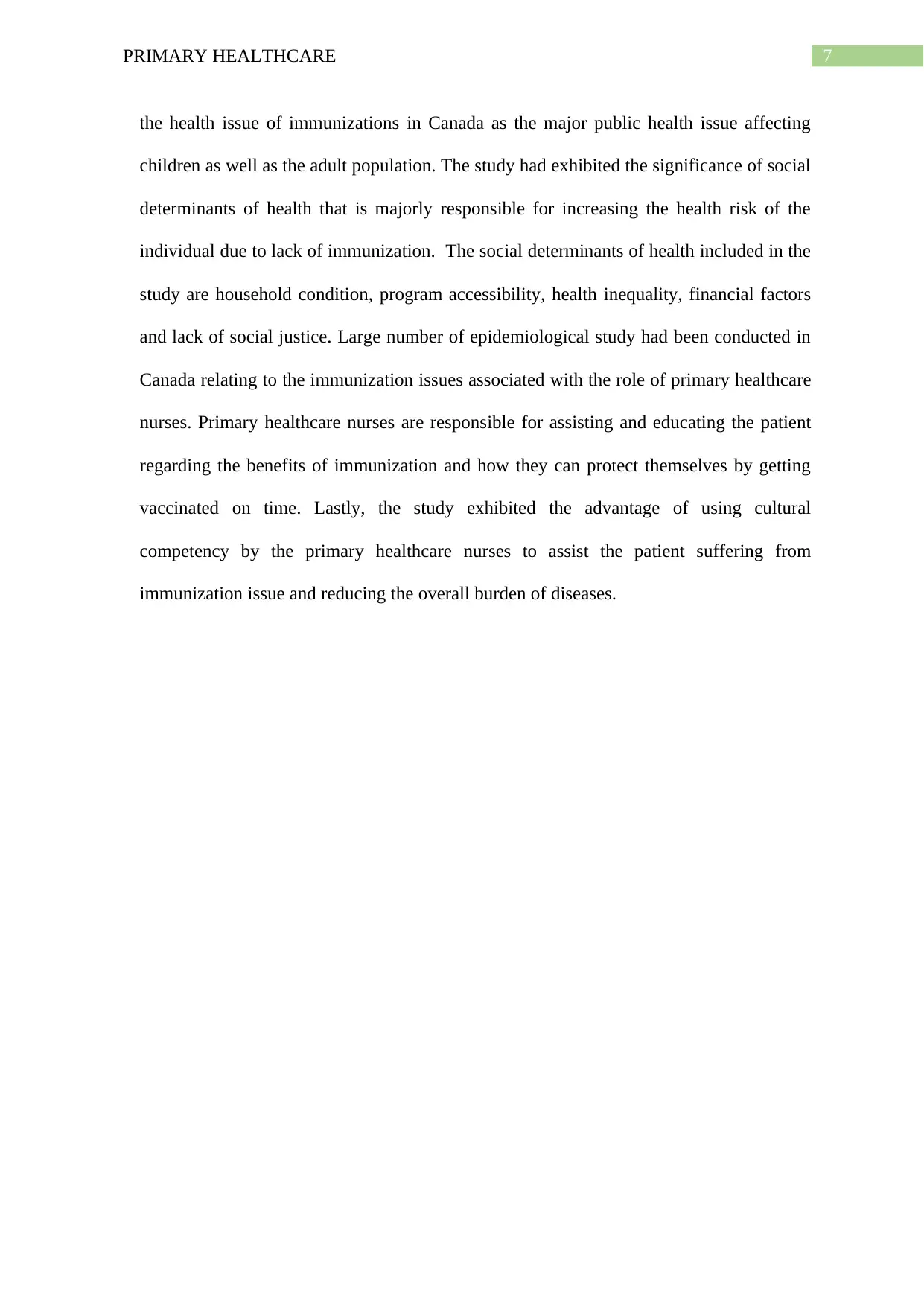
7PRIMARY HEALTHCARE
the health issue of immunizations in Canada as the major public health issue affecting
children as well as the adult population. The study had exhibited the significance of social
determinants of health that is majorly responsible for increasing the health risk of the
individual due to lack of immunization. The social determinants of health included in the
study are household condition, program accessibility, health inequality, financial factors
and lack of social justice. Large number of epidemiological study had been conducted in
Canada relating to the immunization issues associated with the role of primary healthcare
nurses. Primary healthcare nurses are responsible for assisting and educating the patient
regarding the benefits of immunization and how they can protect themselves by getting
vaccinated on time. Lastly, the study exhibited the advantage of using cultural
competency by the primary healthcare nurses to assist the patient suffering from
immunization issue and reducing the overall burden of diseases.
the health issue of immunizations in Canada as the major public health issue affecting
children as well as the adult population. The study had exhibited the significance of social
determinants of health that is majorly responsible for increasing the health risk of the
individual due to lack of immunization. The social determinants of health included in the
study are household condition, program accessibility, health inequality, financial factors
and lack of social justice. Large number of epidemiological study had been conducted in
Canada relating to the immunization issues associated with the role of primary healthcare
nurses. Primary healthcare nurses are responsible for assisting and educating the patient
regarding the benefits of immunization and how they can protect themselves by getting
vaccinated on time. Lastly, the study exhibited the advantage of using cultural
competency by the primary healthcare nurses to assist the patient suffering from
immunization issue and reducing the overall burden of diseases.
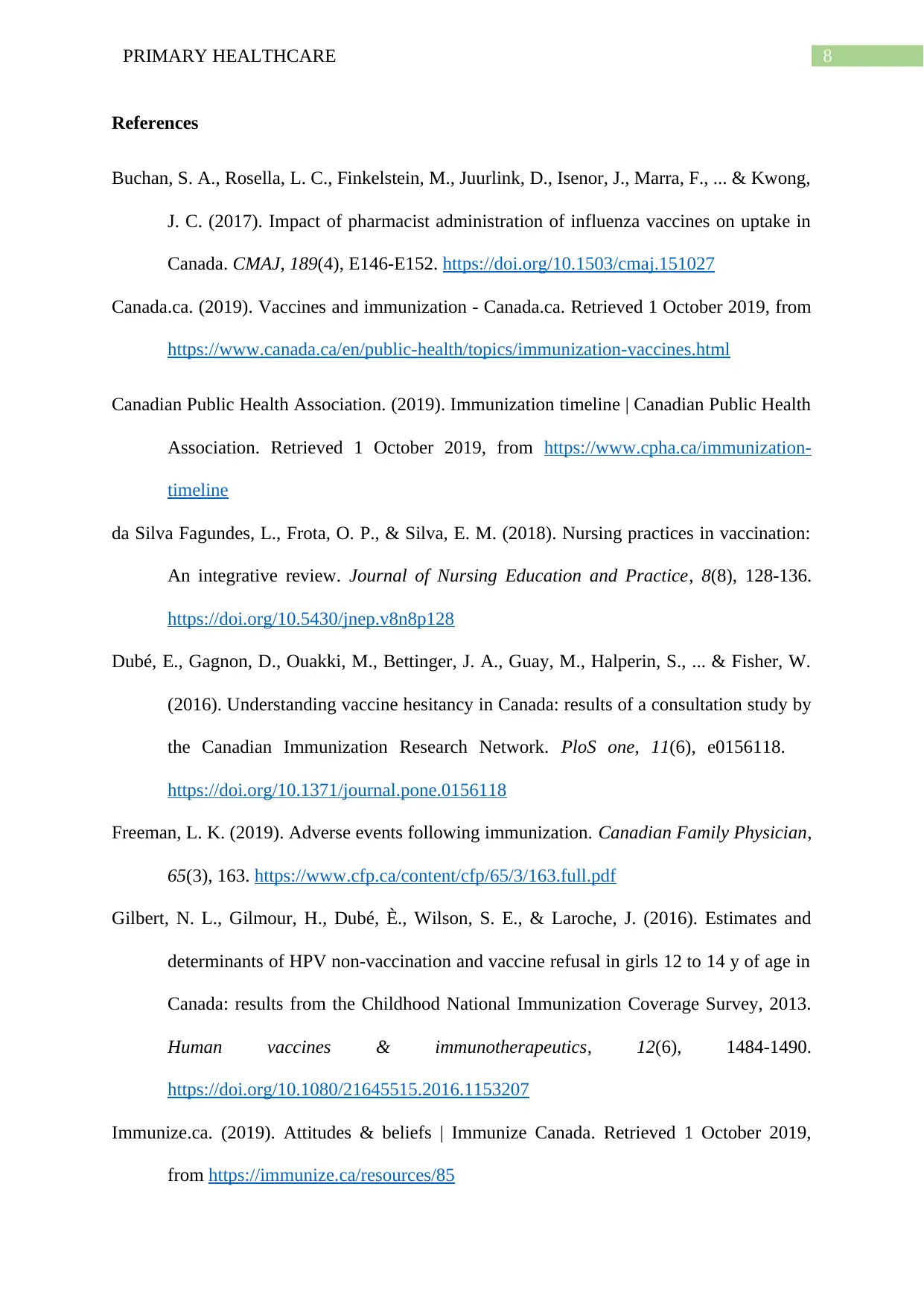
8PRIMARY HEALTHCARE
References
Buchan, S. A., Rosella, L. C., Finkelstein, M., Juurlink, D., Isenor, J., Marra, F., ... & Kwong,
J. C. (2017). Impact of pharmacist administration of influenza vaccines on uptake in
Canada. CMAJ, 189(4), E146-E152. https://doi.org/10.1503/cmaj.151027
Canada.ca. (2019). Vaccines and immunization - Canada.ca. Retrieved 1 October 2019, from
https://www.canada.ca/en/public-health/topics/immunization-vaccines.html
Canadian Public Health Association. (2019). Immunization timeline | Canadian Public Health
Association. Retrieved 1 October 2019, from https://www.cpha.ca/immunization-
timeline
da Silva Fagundes, L., Frota, O. P., & Silva, E. M. (2018). Nursing practices in vaccination:
An integrative review. Journal of Nursing Education and Practice, 8(8), 128-136.
https://doi.org/10.5430/jnep.v8n8p128
Dubé, E., Gagnon, D., Ouakki, M., Bettinger, J. A., Guay, M., Halperin, S., ... & Fisher, W.
(2016). Understanding vaccine hesitancy in Canada: results of a consultation study by
the Canadian Immunization Research Network. PloS one, 11(6), e0156118.
https://doi.org/10.1371/journal.pone.0156118
Freeman, L. K. (2019). Adverse events following immunization. Canadian Family Physician,
65(3), 163. https://www.cfp.ca/content/cfp/65/3/163.full.pdf
Gilbert, N. L., Gilmour, H., Dubé, È., Wilson, S. E., & Laroche, J. (2016). Estimates and
determinants of HPV non-vaccination and vaccine refusal in girls 12 to 14 y of age in
Canada: results from the Childhood National Immunization Coverage Survey, 2013.
Human vaccines & immunotherapeutics, 12(6), 1484-1490.
https://doi.org/10.1080/21645515.2016.1153207
Immunize.ca. (2019). Attitudes & beliefs | Immunize Canada. Retrieved 1 October 2019,
from https://immunize.ca/resources/85
References
Buchan, S. A., Rosella, L. C., Finkelstein, M., Juurlink, D., Isenor, J., Marra, F., ... & Kwong,
J. C. (2017). Impact of pharmacist administration of influenza vaccines on uptake in
Canada. CMAJ, 189(4), E146-E152. https://doi.org/10.1503/cmaj.151027
Canada.ca. (2019). Vaccines and immunization - Canada.ca. Retrieved 1 October 2019, from
https://www.canada.ca/en/public-health/topics/immunization-vaccines.html
Canadian Public Health Association. (2019). Immunization timeline | Canadian Public Health
Association. Retrieved 1 October 2019, from https://www.cpha.ca/immunization-
timeline
da Silva Fagundes, L., Frota, O. P., & Silva, E. M. (2018). Nursing practices in vaccination:
An integrative review. Journal of Nursing Education and Practice, 8(8), 128-136.
https://doi.org/10.5430/jnep.v8n8p128
Dubé, E., Gagnon, D., Ouakki, M., Bettinger, J. A., Guay, M., Halperin, S., ... & Fisher, W.
(2016). Understanding vaccine hesitancy in Canada: results of a consultation study by
the Canadian Immunization Research Network. PloS one, 11(6), e0156118.
https://doi.org/10.1371/journal.pone.0156118
Freeman, L. K. (2019). Adverse events following immunization. Canadian Family Physician,
65(3), 163. https://www.cfp.ca/content/cfp/65/3/163.full.pdf
Gilbert, N. L., Gilmour, H., Dubé, È., Wilson, S. E., & Laroche, J. (2016). Estimates and
determinants of HPV non-vaccination and vaccine refusal in girls 12 to 14 y of age in
Canada: results from the Childhood National Immunization Coverage Survey, 2013.
Human vaccines & immunotherapeutics, 12(6), 1484-1490.
https://doi.org/10.1080/21645515.2016.1153207
Immunize.ca. (2019). Attitudes & beliefs | Immunize Canada. Retrieved 1 October 2019,
from https://immunize.ca/resources/85
⊘ This is a preview!⊘
Do you want full access?
Subscribe today to unlock all pages.

Trusted by 1+ million students worldwide
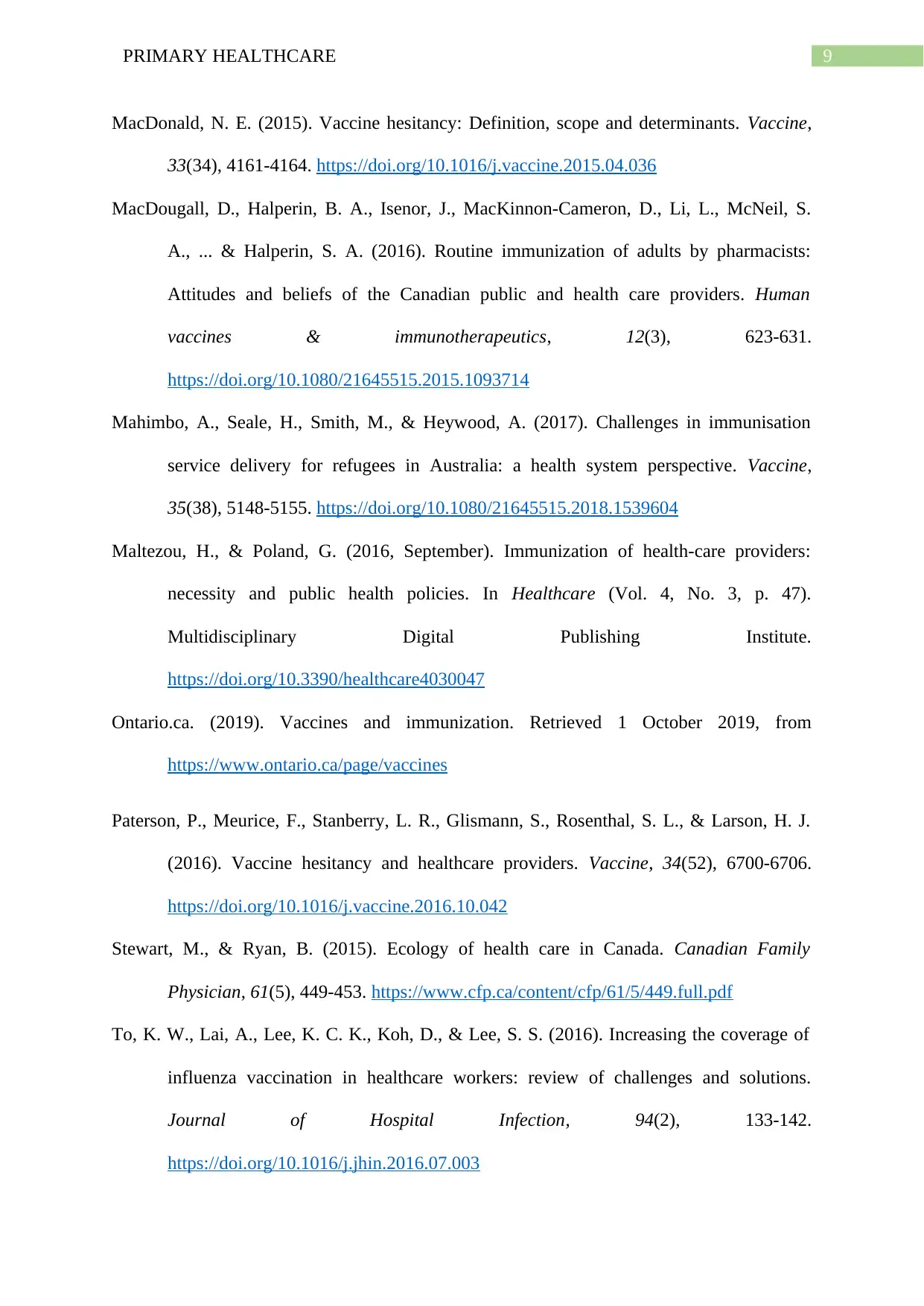
9PRIMARY HEALTHCARE
MacDonald, N. E. (2015). Vaccine hesitancy: Definition, scope and determinants. Vaccine,
33(34), 4161-4164. https://doi.org/10.1016/j.vaccine.2015.04.036
MacDougall, D., Halperin, B. A., Isenor, J., MacKinnon-Cameron, D., Li, L., McNeil, S.
A., ... & Halperin, S. A. (2016). Routine immunization of adults by pharmacists:
Attitudes and beliefs of the Canadian public and health care providers. Human
vaccines & immunotherapeutics, 12(3), 623-631.
https://doi.org/10.1080/21645515.2015.1093714
Mahimbo, A., Seale, H., Smith, M., & Heywood, A. (2017). Challenges in immunisation
service delivery for refugees in Australia: a health system perspective. Vaccine,
35(38), 5148-5155. https://doi.org/10.1080/21645515.2018.1539604
Maltezou, H., & Poland, G. (2016, September). Immunization of health-care providers:
necessity and public health policies. In Healthcare (Vol. 4, No. 3, p. 47).
Multidisciplinary Digital Publishing Institute.
https://doi.org/10.3390/healthcare4030047
Ontario.ca. (2019). Vaccines and immunization. Retrieved 1 October 2019, from
https://www.ontario.ca/page/vaccines
Paterson, P., Meurice, F., Stanberry, L. R., Glismann, S., Rosenthal, S. L., & Larson, H. J.
(2016). Vaccine hesitancy and healthcare providers. Vaccine, 34(52), 6700-6706.
https://doi.org/10.1016/j.vaccine.2016.10.042
Stewart, M., & Ryan, B. (2015). Ecology of health care in Canada. Canadian Family
Physician, 61(5), 449-453. https://www.cfp.ca/content/cfp/61/5/449.full.pdf
To, K. W., Lai, A., Lee, K. C. K., Koh, D., & Lee, S. S. (2016). Increasing the coverage of
influenza vaccination in healthcare workers: review of challenges and solutions.
Journal of Hospital Infection, 94(2), 133-142.
https://doi.org/10.1016/j.jhin.2016.07.003
MacDonald, N. E. (2015). Vaccine hesitancy: Definition, scope and determinants. Vaccine,
33(34), 4161-4164. https://doi.org/10.1016/j.vaccine.2015.04.036
MacDougall, D., Halperin, B. A., Isenor, J., MacKinnon-Cameron, D., Li, L., McNeil, S.
A., ... & Halperin, S. A. (2016). Routine immunization of adults by pharmacists:
Attitudes and beliefs of the Canadian public and health care providers. Human
vaccines & immunotherapeutics, 12(3), 623-631.
https://doi.org/10.1080/21645515.2015.1093714
Mahimbo, A., Seale, H., Smith, M., & Heywood, A. (2017). Challenges in immunisation
service delivery for refugees in Australia: a health system perspective. Vaccine,
35(38), 5148-5155. https://doi.org/10.1080/21645515.2018.1539604
Maltezou, H., & Poland, G. (2016, September). Immunization of health-care providers:
necessity and public health policies. In Healthcare (Vol. 4, No. 3, p. 47).
Multidisciplinary Digital Publishing Institute.
https://doi.org/10.3390/healthcare4030047
Ontario.ca. (2019). Vaccines and immunization. Retrieved 1 October 2019, from
https://www.ontario.ca/page/vaccines
Paterson, P., Meurice, F., Stanberry, L. R., Glismann, S., Rosenthal, S. L., & Larson, H. J.
(2016). Vaccine hesitancy and healthcare providers. Vaccine, 34(52), 6700-6706.
https://doi.org/10.1016/j.vaccine.2016.10.042
Stewart, M., & Ryan, B. (2015). Ecology of health care in Canada. Canadian Family
Physician, 61(5), 449-453. https://www.cfp.ca/content/cfp/61/5/449.full.pdf
To, K. W., Lai, A., Lee, K. C. K., Koh, D., & Lee, S. S. (2016). Increasing the coverage of
influenza vaccination in healthcare workers: review of challenges and solutions.
Journal of Hospital Infection, 94(2), 133-142.
https://doi.org/10.1016/j.jhin.2016.07.003
Paraphrase This Document
Need a fresh take? Get an instant paraphrase of this document with our AI Paraphraser
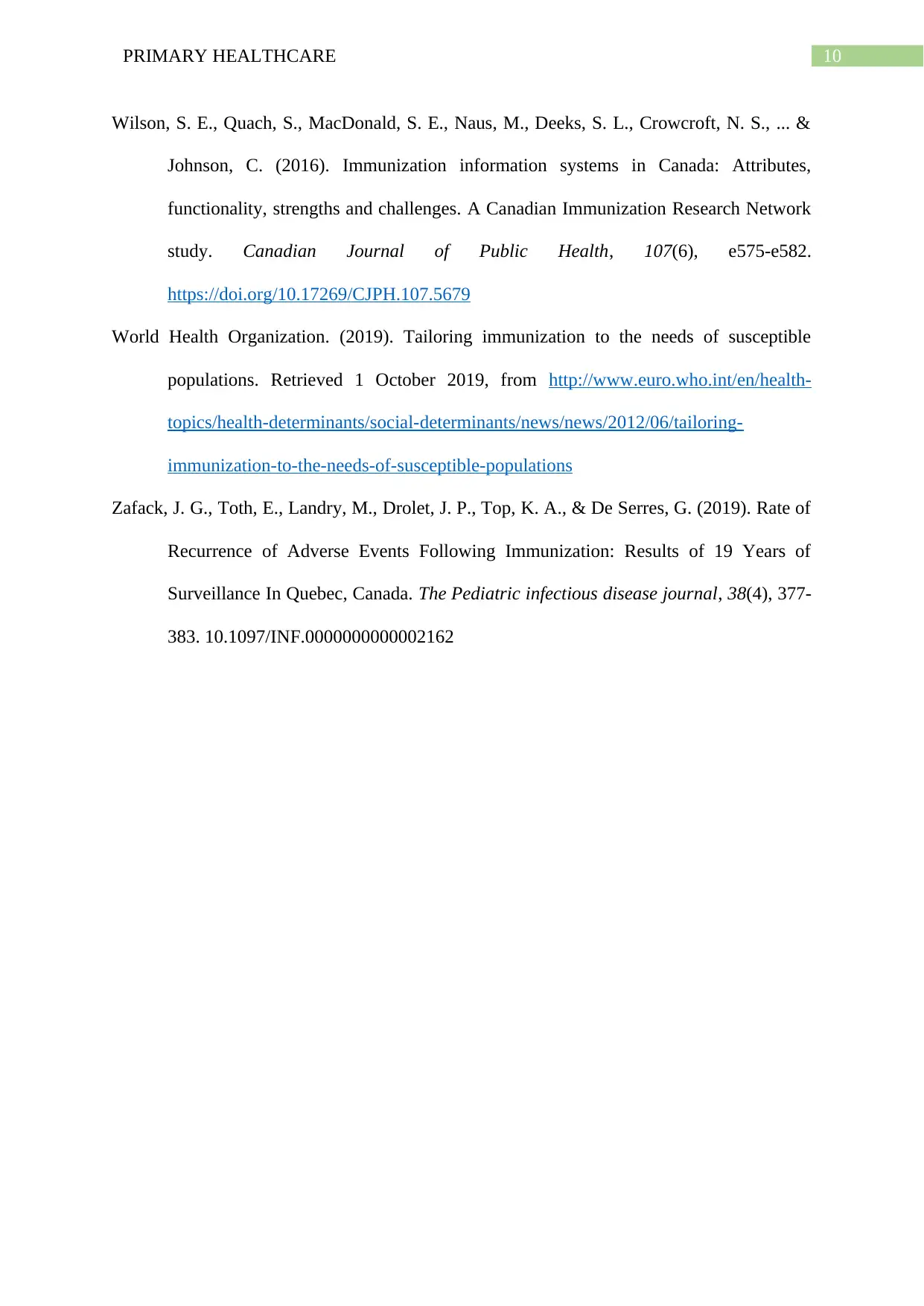
10PRIMARY HEALTHCARE
Wilson, S. E., Quach, S., MacDonald, S. E., Naus, M., Deeks, S. L., Crowcroft, N. S., ... &
Johnson, C. (2016). Immunization information systems in Canada: Attributes,
functionality, strengths and challenges. A Canadian Immunization Research Network
study. Canadian Journal of Public Health, 107(6), e575-e582.
https://doi.org/10.17269/CJPH.107.5679
World Health Organization. (2019). Tailoring immunization to the needs of susceptible
populations. Retrieved 1 October 2019, from http://www.euro.who.int/en/health-
topics/health-determinants/social-determinants/news/news/2012/06/tailoring-
immunization-to-the-needs-of-susceptible-populations
Zafack, J. G., Toth, E., Landry, M., Drolet, J. P., Top, K. A., & De Serres, G. (2019). Rate of
Recurrence of Adverse Events Following Immunization: Results of 19 Years of
Surveillance In Quebec, Canada. The Pediatric infectious disease journal, 38(4), 377-
383. 10.1097/INF.0000000000002162
Wilson, S. E., Quach, S., MacDonald, S. E., Naus, M., Deeks, S. L., Crowcroft, N. S., ... &
Johnson, C. (2016). Immunization information systems in Canada: Attributes,
functionality, strengths and challenges. A Canadian Immunization Research Network
study. Canadian Journal of Public Health, 107(6), e575-e582.
https://doi.org/10.17269/CJPH.107.5679
World Health Organization. (2019). Tailoring immunization to the needs of susceptible
populations. Retrieved 1 October 2019, from http://www.euro.who.int/en/health-
topics/health-determinants/social-determinants/news/news/2012/06/tailoring-
immunization-to-the-needs-of-susceptible-populations
Zafack, J. G., Toth, E., Landry, M., Drolet, J. P., Top, K. A., & De Serres, G. (2019). Rate of
Recurrence of Adverse Events Following Immunization: Results of 19 Years of
Surveillance In Quebec, Canada. The Pediatric infectious disease journal, 38(4), 377-
383. 10.1097/INF.0000000000002162
1 out of 11
Related Documents
Your All-in-One AI-Powered Toolkit for Academic Success.
+13062052269
info@desklib.com
Available 24*7 on WhatsApp / Email
![[object Object]](/_next/static/media/star-bottom.7253800d.svg)
Unlock your academic potential
Copyright © 2020–2025 A2Z Services. All Rights Reserved. Developed and managed by ZUCOL.





